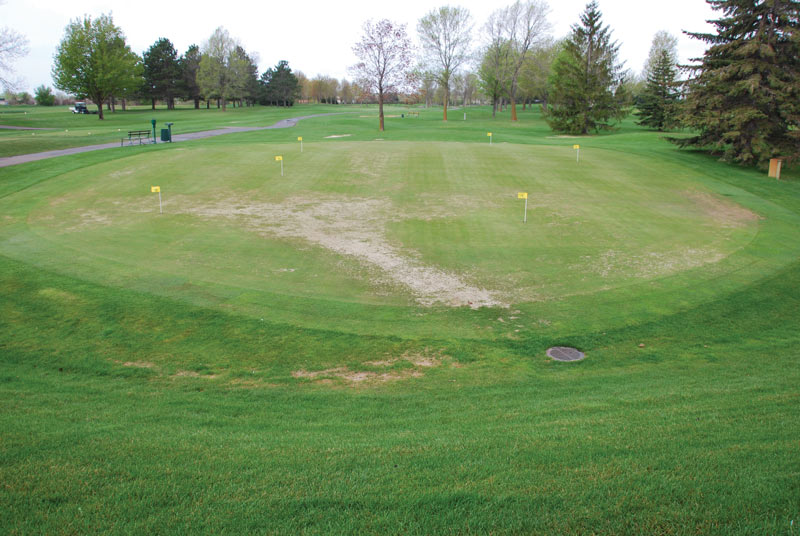
In cold climates, unprotected turf is subject to several types of winter injury. Photo by Andrew Larsen
Editor’s note: The following article first appeared in the March 2010 issue of GCM. Because of its timeless insights for turf managers, we’ve dusted it off and are presenting it anew.
Over the years, superintendents across the northern U.S. and Canada have used many materials and methods to protect greens from winter injury, and every year, new products are introduced to the market. The costs of the various winter protection programs vary widely, but whether superintendents use the latest in greens cover technology or the oldest “tried and true” method, most of them invest some money in protecting their greens.
The objectives of this project were to gather information about the materials superintendents use as putting green covers, analyze how and why they use them, compare that information with the recommendations of the manufacturers, and develop a cost-per-cover analysis. We did not attempt to compare the effectiveness of different winter protection programs. Because every green is unique, no single winter protection program will work for every green. The superintendent must evaluate each situation and determine the best course of action.
Types of winter injury to turf
To develop an effective winter protection program, superintendents must first know what type of injury they are trying to prevent. Therefore, a basic understanding of the different types of winter injury is critical.
Desiccation
Desiccation damage is a threat anytime water loss exceeds uptake. There are two causes of winter desiccation of greens. The first, atmospheric drought, occurs when drying winds combine with relatively low atmospheric humidity. This is a common situation in winter. Plants are unable to replace lost moisture because the soil is frozen. This type of damage occurs most often on high or sloped areas with greater wind exposure, and it’s usually restricted to small areas.
The second cause of desiccation injury is soil drought. This injury is more common during the growing season, but it can also be a factor in winter, especially on greens with a high sand content and limited water-holding capacity. Superintendents who work in cold climates attempt to strike a delicate balance every year. They must allow the soil to dry out so the plants will acclimate to the colder weather and achieve maximum winter hardiness. However, unseasonably warm, dry weather or late snow cover can lead to desiccation. Damage caused by soil drought tends to cover a much wider area (1).
A few pointers: Annual bluegrass (Poa annua) is more susceptible to damage than creeping bentgrass (Agrostis stolonifera); greens in full sun are more likely to be damaged; and desiccation damage can occur in just a few days (3).
Crown hydration
Crown hydration kills putting green turf every year across the northern U.S. and Canada. Despite a considerable amount of research into how it happens and how to prevent it, crown hydration injury continues to confound superintendents. Several factors combine to cause this type of injury. Those factors are different for every golf course, and they interact differently each year.
Annual bluegrass is much more susceptible to crown hydration injury than creeping bentgrass is, because annual bluegrass has higher crown moisture content (11). Creeping bentgrass is also better at storing carbohydrates and is therefore able to remain dormant longer in the spring transitional period, when much of the damage occurs (11). In addition, excessive nitrogen fertilization during the fall hardening-off period will cause the plants to retain moisture, making them more susceptible to crown hydration damage. Maintaining adequate levels of potassium is also very important during the fall hardening-off period (8).

Thawing and refreezing or contact with water can change the moisture level within the turfgrass plant and lead to crown hydration injury in winter. Photo by E. McManus
Finally, most researchers seem to agree that the single most important factor contributing to crown hydration injury is poor surface drainage (2). Even if everything is done correctly, the turf may still suffer crown hydration damage if water is standing on the greens during the shoulders of the season.
Anoxia
Researchers have long theorized that toxic gases could build up under ice and cause damage to turf, but for many years, there was little scientific evidence of this type of injury. Most researchers think the more likely cause of damage under ice is crown hydration (2). The introduction of impermeable covers, designed to protect against crown hydration, has given rise to new concerns about anoxia injury.
Research is ongoing about the various factors involved in anoxia injury. As with crown hydration, how these factors interact to cause the injury is not always clear-cut. Researchers have learned that soil microbial activity and the resulting respiration play an important role in the anoxia injury (9). Therefore, turfgrass grown in soils that are higher in organic carbon are much more likely to suffer anoxia injury when gas exchange is restricted. This is significant, because annual bluegrass is more susceptible to anoxia injury than creeping bentgrass is, and older greens that have more annual bluegrass are also more likely to be push-up-style greens with a native soil base and a higher percentage of organic carbon.
Other factors to consider include the temperature under the cover and the winter hardiness of the plants before they were covered. Plants not sufficiently hardened off in fall will respire more under the cover. In addition, research has shown that when soil temperatures at the crown level remained between 28 F (-2 C) and 17.6 F (-8 C), oxygen and carbon dioxide levels remained constant. But when temperatures rose above 28 F, oxygen levels began to fall and carbon dioxide concentrations increased (10).
Researchers are currently examining whether active and/or passive ventilation under an impermeable cover makes a significant difference in the oxygen level and the accumulation of carbon dioxide. Preliminary results of the study indicate that passive ventilation was equally as effective as active ventilation at maintaining oxygen levels and reducing carbon dioxide buildup (10).
Two other types of winter turf injury
Direct low-temperature kill and crown dehydration are not discussed here in detail because no covers target these types of injuries. However, it is important for superintendents to know how these injuries relate to other types of winter injury.
Direct low-temperature kill
Research indicates that in most years, a normal LT50 (the lowest temperature at which 50% of the plants in a given population will survive) will be about -4 F (-20 C) for annual bluegrass and -40 F (-40 C) for creeping bentgrass. This value will vary depending on the year, the plant species, and the climatic and environmental factors (11). The stated LT50s are the maximum cold hardiness the plants will achieve; the plants will gradually lose cold hardiness as the winter progresses.
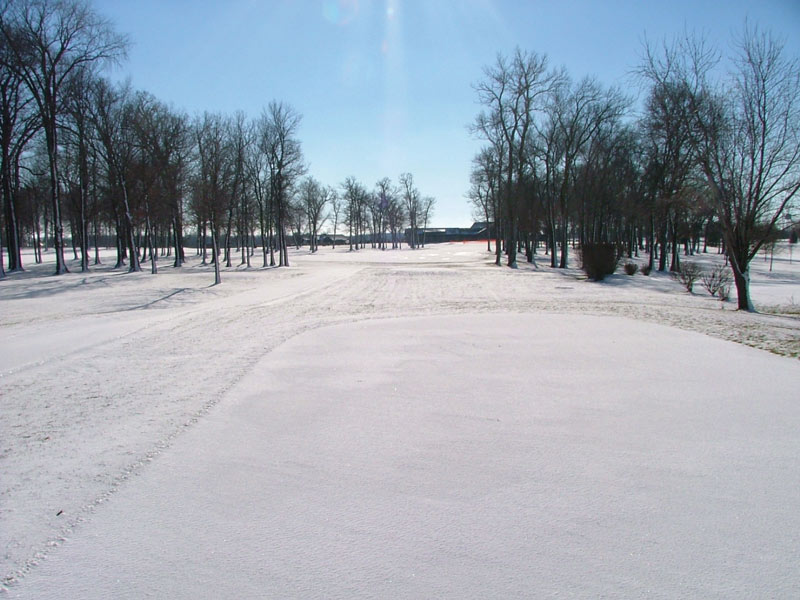
Direct low-temperature kill takes place only under extremely cold conditions. Half the plants in a given creeping bentgrass population will still be alive if the temperature dips to -40 F. Photo by Andrew Larsen
The difference between direct low-temperature kill and crown hydration injury is the moisture content within the plant. As plants harden off in fall, they reach an optimal moisture level within the crown. The LT50 is the temperature at which 50% of the population will die even if this moisture level remains constant. Once these plants are exposed to higher temperatures, thawing and refreezing, or free water, the moisture level within the plant changes. Any injury sustained after that point is considered crown hydration injury.
Crown dehydration
Crown dehydration occurs when ice crystals form outside the cells of the plant. These expanding ice crystals extract water from inside the cells (8). This damage is similar to desiccation injury in that it is caused by insufficient moisture within the cells of the plant. It is different from desiccation injury in the way in which the moisture is lost. Desiccation occurs when the moisture is lost to the atmosphere and typically takes several days to occur. In contrast, crown dehydration injury occurs when ice crystals form in the extracellular spaces of the plant and can take place almost immediately after plants become encased in ice (7).
The survey
Early winter cover research dates back to the late 1950s, when James Watson, Ph.D., of The Toro Co. and superintendents from Minnesota, Illinois and Canada tried a number of different materials to see whether they could stop winter from ravaging their greens. One Canadian superintendent was quoted as saying he felt they “may have opened a brand new era in green maintenance” (13).
For this project, a survey was sent to about 315 members of the Minnesota GCSA. We received 31 completed surveys, for a response rate of approximately 10%. The purpose of the survey was to learn what types of winter protection programs superintendents were using and the costs associated with implementing those programs. Follow-up interviews were conducted with approximately half the respondents. The purpose of the interviews was to learn why superintendents chose a particular winter protection program, and to discuss the effectiveness of their chosen program.
Over the years, superintendents have experimented with many different types of materials to protect their greens, and winter protection programs continue to evolve. Here, I analyze and compare three different types of covers commonly used to protect against winter injury, and one “no cover” winter protection program. See the table Is this type of cover effective against this type of injury? for a summary of the results.
Permeable non-insulating turf covers
The most widely used example of a permeable non-insulating cover in the Upper Midwest is the Evergreen cover. Superintendents most commonly use these covers to accelerate spring green-up. The covers are also used to help the recovery process when winter damage occurs. However, some superintendents use these types of covers for winter protection. Survey results showed that these superintendents are usually managing greens that are relatively young or have recently been rebuilt or regrassed. The greens have good surface drainage, and the turf is primarily creeping bentgrass. Desiccation is the main type of injury these superintendents are trying to prevent.
Conventional wisdom would suggest that covers completely permeable by water and air would give no protection against crown hydration injury. In follow-up interviews, superintendents stated that permeable non-insulating covers were not an effective deterrent to crown hydration injury. They agreed, however, that these covers were effective at warming the surface in spring and thereby accelerating the recovery process. These observations have been confirmed in scientific studies (5).
Because this type of cover is completely permeable by both water and air, it will not contribute to anoxia injury. However, because this type of cover does not insulate but does allow water to pass through, it cannot prevent the formation of an ice layer and is not an effective deterrent of anoxia caused by ice encasement of the turf.
Cost analysis
The Evergreen cover comes with a three-, seven- or 10-year warranty. All three covers are woven and have the same physical properties. Here, I discuss the “original” cover, which has a seven-year warranty, because all the superintendents surveyed who used Evergreen covers used that model.
At an average cost of $0.30/square foot, the Evergreen has the highest initial cost among the covers commonly used by superintendents for winter protection. However, the company’s website says the expected life span of this cover is 10 years, and the superintendents who participated in the survey and used the cover reported approximately 10 years of use. Therefore, the cover’s long usable life significantly reduces its annual cost.
Superintendents’ estimates of the labor required for installation were considerably greater than the manufacturer’s claims on the website. Actual installation time can vary greatly depending on the weather. Nevertheless, under the right conditions, installation of these covers requires less labor than other covers do.
Permeable insulating turf covers
The most widely used permeable insulating cover, the Curlex Green Saver, is commonly known as an Excelsior blanket. The covers are made of Great Lakes Aspen Excelsior interlocking fibers, and 80% of the fibers are a minimum of 6 inches (15 centimeters) long. Thickness varies, but the covers are typically about 0.75 inch (1.9 centimeters) thick when they are new.
Excelsior blankets are effective at preventing desiccation injury (5). Because the covers are permeable by both water and air, anoxia is not a concern unless the entire profile becomes encased in ice. Even then, the fibrous nature of the cover may create enough porosity to allow gases to move through an ice layer.
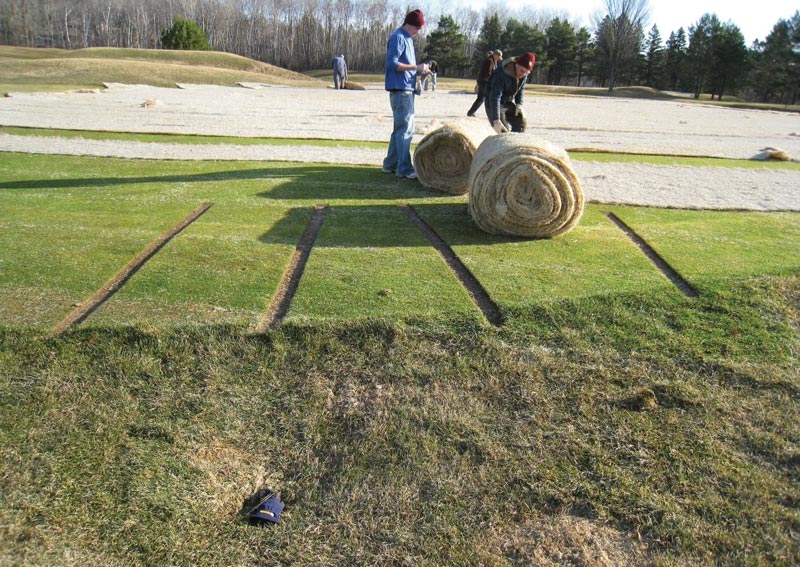
Excelsior blankets were the least expensive of the covers used by superintendents who participated in this survey. Photo courtesy of Brian Horgan
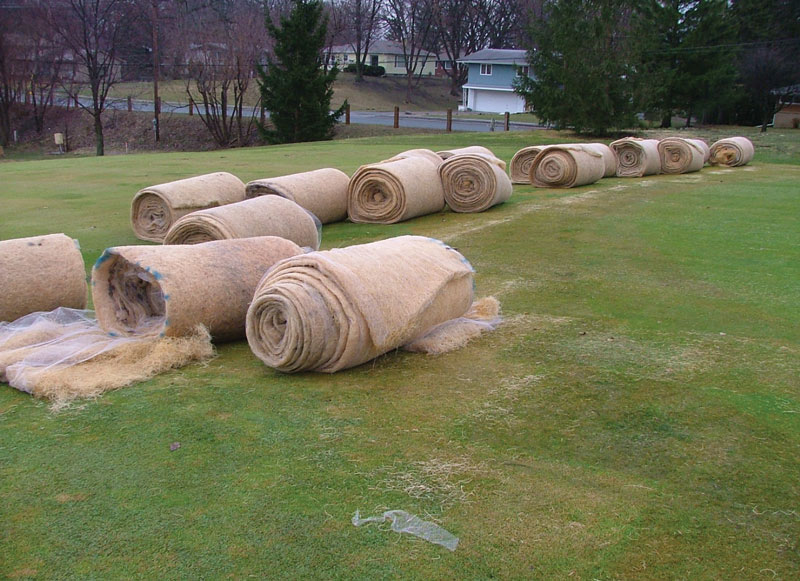
Because they expand to several times their original size as soon as they’re unrolled, Excelsior blankets can be difficult to handle. Photo by Andrew Larsen
The biggest question regarding a permeable insulating cover is its effectiveness in protecting turf against crown hydration injury. Comments from superintendents in follow-up interviews supported the idea that these covers are at least somewhat effective at reducing crown hydration injury. Although these superintendents reported crown hydration in “bird baths,” shaded areas and other areas that held water, the consensus was that the insulating effect of the Excelsior blankets slowed the cycle of thawing and refreezing enough that crown hydration in these areas was reduced to some degree. Their remarks have been substantiated by research (4).
Editor’s note: View the helpful table that accompanies this article, Is this type of cover effective against this type of injury?.
Excelsior blankets have three major drawbacks compared with other types of covers: They are difficult to handle; they require a large amount of storage space; and they have a fairly short usable life span. Superintendents reported they got an average of four years of use out of the Excelsior blankets, compared with seven to 10 years with other types of greens covers.
Cost analysis
Curlex Green Savers (Excelsior blankets) have by far the lowest initial cost among the manufactured greens covers. They average $0.11/square foot, but because of their relatively short life span, their cost per year is comparable to other manufactured covers.
The estimates of the superintendents surveyed varied somewhat, but typically an average of one hour of labor was required to cover 1,000 square feet of putting surface. Roughly the same amount of time was estimated to remove and put away covers in spring. Because these covers require a significant labor force to install and remove, labor availability should be considered when deciding whether to use these blankets.
Storage is also a concern. Excelsior blankets are delivered as nice, tight bundles, but they expand to several times their original size as soon as they are unrolled. They also absorb moisture as soon as they are used in the field. Storage costs can vary greatly; golf courses often rent semitrailers or off-site storage units to store Excelsior blankets.
Weather is not as much of a factor when installing Excelsior blankets. Although a strong wind will move them around, the smaller, heavier Excelsior blankets are much less affected by wind than other types of covers are.
Impermeable turf covers
Impermeable covers can be used with or without an insulating layer, and some have an insulating layer attached. The most widely used impermeable greens cover in the Upper Midwest is the GreenJacket. In follow-up interviews regarding their survey responses, superintendents agreed that as long as the GreenJacket covers were installed properly, they protected against crown hydration by providing an impermeable barrier that prevented ice from touching the turf (6).
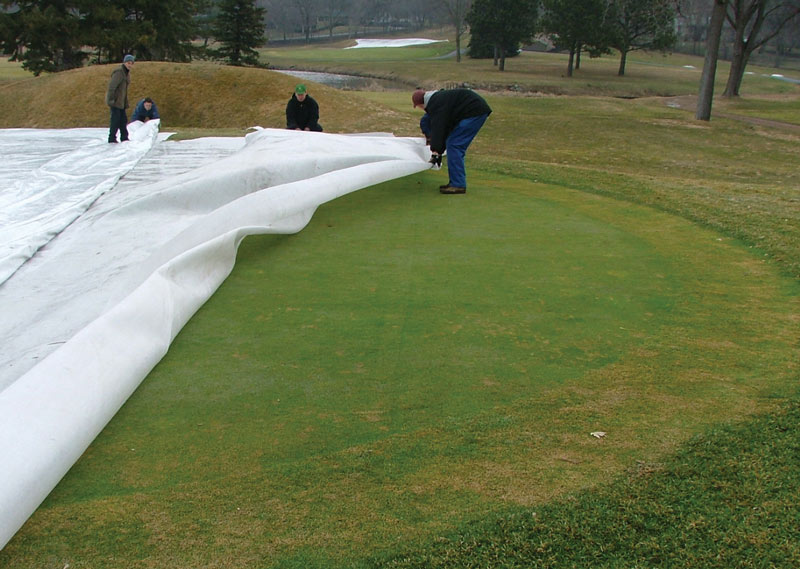
The white GreenJacket impermeable greens cover is designed to reflect sunlight. An optional insulating layer installed between the grass and the cover is shown in this photo. Photo by Andrew Larsen
By themselves, permeable covers will not cause anoxia damage, but anoxia is a concern with impermeable covers (9).
The cover is made of a white opaque polyethylene, designed to reflect sunlight. The superintendents surveyed agreed that the white covers did help reduce light and heat absorption, but the cover alone, without an insulating layer, did not effectively eliminate the possibility of damage related to temperature fluctuations under the cover. Research has shown that temperature variation on a green covered with only an impermeable cover was not statistically different from temperature variation on an uncovered control (5).
The majority of superintendents surveyed for this project indicated that they used some type of insulation. The GreenJacket insulating material used by survey respondents is a closed-cell foam for “thermal surface protection and insulation.” Four of the five superintendents who used this cover said they used the foam insulation in combination with the impermeable cover and had no crown hydration injury.
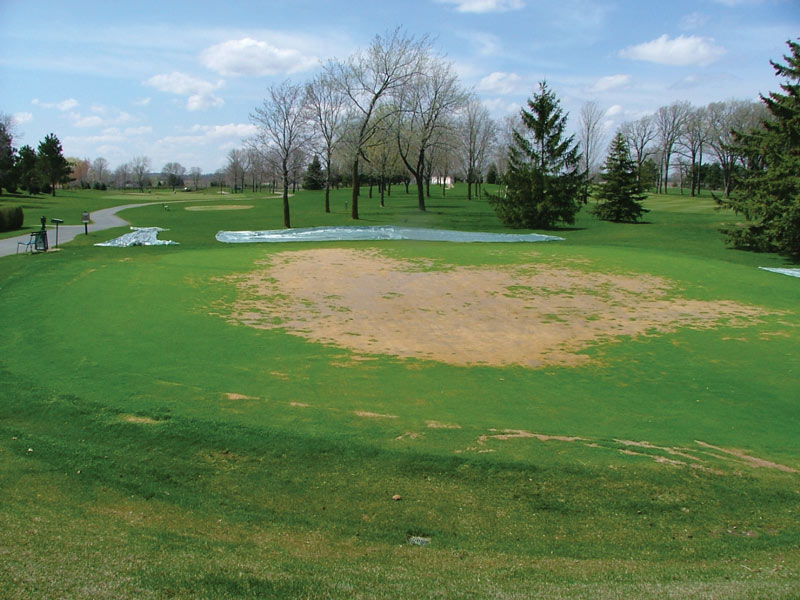
This green was injured under an impermeable cover with no insulating layer. The low area where water sits is not injured, but the center of the green is severely damaged, probably by anoxia or crown hydration. Photo by Andrew Larsen
A few superintendents said they had also used Excelsior blankets in combination with GreenJacket covers as a way of promoting passive gas exchange and buffering temperature fluctuations.
Cost analysis
The initial cost of the impermeable GreenJacket cover alone is $0.16/square foot. The closed-cell foam insulation costs $0.05/square foot. The company offers a five-year warranty on any manufacturing problems with the cover itself. Superintendents surveyed stated they got a minimum of seven years of use from the first-generation GreenJacket covers. A company representative says the improved GreenJackets, introduced in 2008, should have a usable life of 10 years or more.
Assuming the GreenJacket cover has a usable life of 10 years and it is used with the closed-cell foam, the cost would be $0.021/square foot/year. Superintendents also stated that there was some annual replacement cost for the foam insulation. Most estimated they replaced between 3% and 7% annually. Replacing 7% of the foam would add $0.004/square foot/year. The final material cost for the GreenJacket would then be $0.025/square foot/year.
By comparison, the Curlex Green Saver would have a cost of $0.028/square foot/year (assuming a life span of four years for the cover), and the Evergreen cover would have a cost of $0.03/square foot/year (assuming a life span of 10 years). Considering the cost of materials alone, the prices of the different covers, based on a 10-year average life span, are similar.
Labor for installation and removal is also a problem with the impermeable cover and insulation system. As with the Evergreen cover, weather can slow installation of the GreenJacket cover. Wind does not significantly affect cover installation, but it can hinder installation of the foam insulation.
Editor’s note: The handy table Is this type of cover effective against this type of injury? will help you match potential turf damage to proper protection strategy.
Superintendents’ estimates of the amount of labor required for installation were significantly higher for the GreenJacket covers than for the Excelsior blankets. Superintendents who had been using the GreenJacket and insulation system for several years — and had therefore refined their installation technique — estimated that it required approximately 1.5 labor hours to cover 1,000 square feet of putting surface, compared with one hour of labor for the Excelsior blanket. Removing the covers would take a similar amount of time. As with the Excelsior blankets, the amount of labor required to install and remove the GreenJacket covers may prevent their use at some golf courses.
No-cover/topdressing programs
Despite all the advances made with putting green covers and the advantages they offer, most golf courses do not cover their greens in winter. However, just because courses do not use a manufactured cover does not mean they do not have a winter protection program. In our survey, 85% of the respondents who did not use a cover to protect their greens did topdress their greens with sand and use some type of windbreak to deflect the wind and capture snow on their greens.
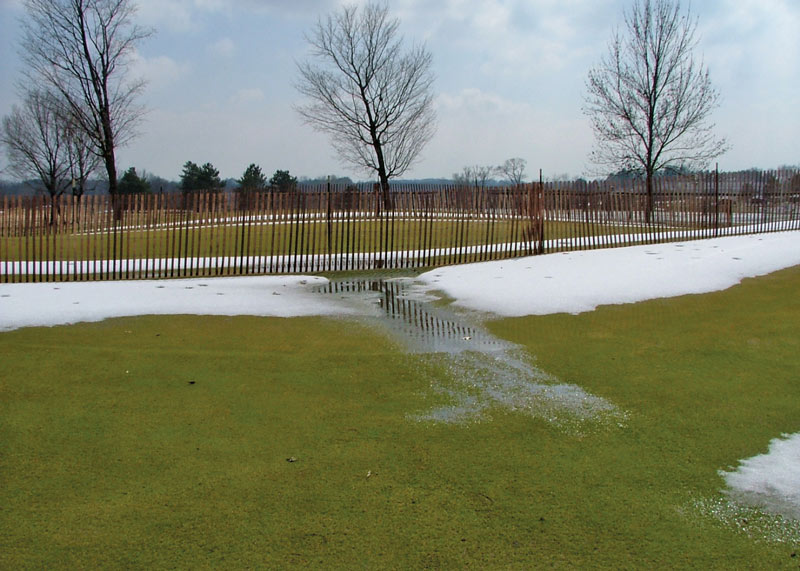
The grass in the area where water has pooled could be subject to freezing, thawing and refreezing, and, as a result, could suffer serious damage from crown hydration. Photo by Andrew Larsen
Superintendents gave several reasons why they chose this approach to protecting their greens, but the most common reason was financial. Other common reasons given for not using covers were skepticism about their effectiveness and fear of the damage the covers might cause. Many superintendents have had poor results with covers and are therefore wary of investing in them. A lack of storage space was another reason given for not using covers.
What are the consequences of not using a cover as it relates to the types of damage discussed here? Does the money saved by not using greens covers balance the risk of winter injury? Superintendents who employ topdressing as a protection scheme are generally trying to protect against desiccation damage. The rationale for using topdressing is that, in the absence of snow cover, the crown of the plant is protected from harsh, drying winds by the layer of sand. This program will work as long as enough sand is applied to cover the crowns and the sand remains in place. The problem, of course, is that sand is easily moved, either by wind or water (in the form of rain or melting snow).
The greatest danger when using a topdressing program is crown hydration injury. With no insulating layer to mitigate the thawing/refreezing cycle and no barrier between the turf and water that may accumulate on the surface, there is a danger of crown hydration injury throughout winter, especially on greens that do not drain well. Most of the superintendents surveyed who used a topdressing winter protection program indicated that they used some type of windbreak to capture as much snow as possible on their greens. Several studies have indicated that the best form of winter protection is a thick, dry, stable snow cover (4,5). Unfortunately, Mother Nature offers no guarantees, and cycles of thawing and refreezing as well as winter rainstorms can thwart this strategy.
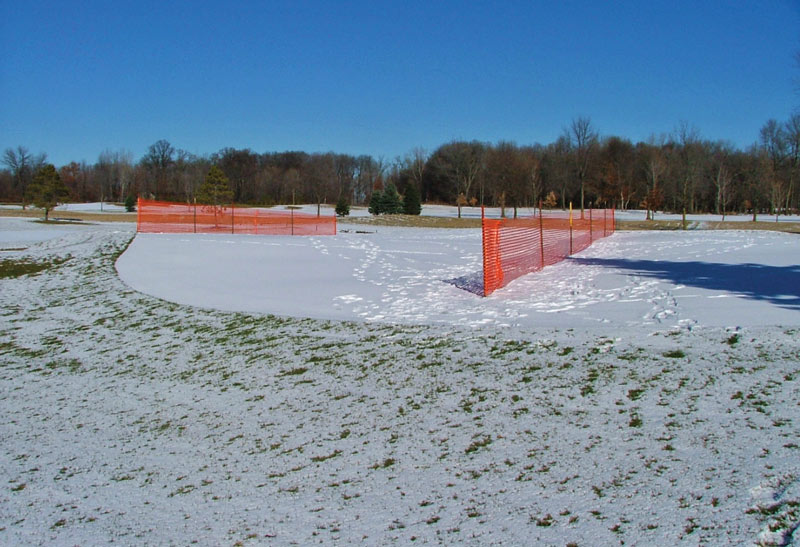
Superintendents who do not use a cover to protect greens often use a fence or some type of windbreak to deflect wind and capture snow on the surface of their greens. Photo by Andrew Larsen
Some superintendents indicated they were concerned about using covers because of the possibility of anoxia injury. Based on the research, this concern is certainly legitimate. However, studies have shown that anoxia injury is possible even with a topdressing winter protection program. As stated earlier, determining exactly when anoxia damage takes place is difficult, because, as with crown hydration, many factors interact to cause the injury. Anoxic conditions like those that occur under an impermeable cover can also occur under ice (12). Anoxic conditions under ice may lead to a loss of cold hardiness, which may in turn lead to direct low-temperature injury or, more likely, crown hydration injury.
Cost analysis
Superintendents using a no-cover winter protection program reported using a wide variety of methods to protect their greens. Most said they topdressed their greens with sand (two of the 31 respondents said they did nothing at all), but the amount of sand applied varied greatly. Some reported they sprayed an antidesiccant; others reported using black sand or Milorganite to help warm the soil in spring. Most superintendents said they used some type of windbreak on the areas most exposed to wind. The programs were varied and adapted by each superintendent to meet specific needs.
One universal truth about the topdressing programs was that they were all less expensive to implement than programs that employed covers. Material costs, mostly for topdressing sand, ranged from $500 to $1,500 among those surveyed, and the vast majority of superintendents reported they did not budget extra money for labor to implement such programs.
Conclusions
We continue to learn more about winter injury every year, and our ability to prevent or minimize it continues to improve. Often, however, the most exhaustive preparations and the most advanced covering systems cannot prevent winter damage. At times like these, we seem to be at the mercy of the weather, and a healthy dose of good luck is the only way to avoid winter injury. This has been the prevailing opinion of most superintendents and researchers through decades of work with winter injury, but attitudes are beginning to change.
Superintendents acknowledge that greens covers are not a panacea for winter injury problems. However, they understand that a properly designed winter protection program that addresses the particular needs of the area being protected gives them the best chance of success. As our understanding of the various types of winter injury continues to improve and the methods for protecting greens continue to evolve, luck will be less and less of a factor.
Acknowledgments
Thanks to the members of the Minnesota GCSA who took time to fill out the winter protection survey, and special thanks to the superintendents who took extra time for the follow-up interviews.
The research says ...
- Superintendents in the northern U.S. and Canada use various means of protecting greens from winter injuries such as desiccation, crown hydration, anoxia, low-temperature kill and crown dehydration.
- Depending on the type of turf they are managing, the type of injury they are trying to prevent and various environmental factors, superintendents choose either permeable non-insulating covers, permeable insulating covers, impermeable covers or no-cover protection programs.
- Most superintendents who do not use covers topdress their greens with sand and try to maintain snow cover on their greens to prevent desiccation damage. Crown hydration injury is the greatest danger with a topdressing program.
Literature cited
- Beard, J.B. 1972. Ten years of research on winter injury on golf courses: causes and prevention. USGA Green Section Record 10(6):3-8.
- Beard, J.B. 1996. Low-temperature kill and ice sheets. Golf Course Management 64(5):60-64.
- Charbonneau, P. 2007. Tough turf: surviving winter’s wrath. GreenMaster 42(2):30-34.
- Dionne, J. 2000. Winter protection of annual bluegrass golf greens. USGA Green Section Record 38(5):11-13.
- Dionne, J., and Y. Desjardins. 1996. Under the blanket. GreenMaster 31(6):4, 6, 8.
- Dionne, J., P-A. Dubé, M. Laganière and Y. Desjardins. 1999. Golf green soil and crown-level temperatures under winter protective covers. Agronomy Journal 91:227-233.
- Minner, D., and F. Valverde. 2007. Field evaluation of winterkill in annual bluegrass and creeping bentgrass. Golf Course Management 75(9):88-93.
- Roberts, J.M. 1993. Understanding crown hydration damage. Golf Course Management 61(10):48, 52, 54.
- Rochette, P., J. Dionne, Y. Castonguay and Y. Desjardins. 2006. Atmospheric composition under impermeable winter golf green protections. Crop Science 46:1644-1655.
- Tompkins, D.K., P. Rochette and J. Ross. 2008. Mitigation of anoxia under ice and impermeable covers on annual bluegrass putting greens. http://ptrc.oldscollege.ca/documents/MitAnoxiaIceCoversBGPuttingGreens.pdf (verified Dec. 12, 2009).
- Tompkins, D.K., J.B. Ross and D.L. Moroz. 2000. Dehardening of annual bluegrass and creeping bentgrass during late winter and early spring. Agronomy Journal 92:5-9.
- Tompkins, D.K., J.B. Ross and D.L. Moroz. 2004. Effects of ice cover on annual bluegrass and creeping bentgrass putting greens. Crop Science 44:2175-2179.
- Watson, J.R., and L. Wicklund. 1962. Plastic covers protect greens from winter damage. Golf Course Reporter 30(10):30-32, 36.
Andrew Larsen, a GCSAA member since 1996, graduated from the University of Minnesota with a master’s degree in agriculture and was recently the superintendent at Medina (Minn.) Golf & Country Club. Brian Horgan is an associate professor in the Department of Horticultural Science at the University of Minnesota, Twin Cities campus.